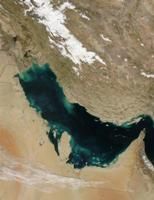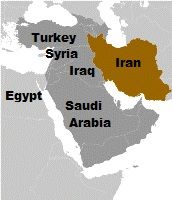An Iran With Nuclear Weapons Strikes Fear Across the Middle East
Written by Mike Bennett
 For years experts have warned that Iran is close to producing nuclear weapons and that Israel would launch a strike to take them out. Is it too late? And is Israel the only one concerned?
For years experts have warned that Iran is close to producing nuclear weapons and that Israel would launch a strike to take them out. Is it too late? And is Israel the only one concerned?
The latest report by the UN nuclear watchdog, the IAEA, for the first time said, “Iran has carried out activities relevant to the development of a nuclear explosive device” and that “some activities may still be ongoing” (“Iran Vows Not to Retreat on Nuclear Programme,” Financial Times).
This only confirms what experts and neighbors of Iran have suspected for years. Speculation is widespread that Israel, which the Iranian leaders often threaten to wipe off the map, may attempt an airstrike to destroy Iran’s nuclear program before the end of this year. But the IAEA report also confirmed that the Iranians had moved nuclear material to an underground site near Qom. Is much of Iran’s nuclear program now out of the reach of even bunker-busting bombs?
Israel is far from the only concerned country. The Saudi ambassador to the United States was quoted in a diplomatic message released by WikiLeaks advising the U.S. to attack Iran and put an end to its nuclear-weapons program—“to cut off the head of the snake” (The Washington Times).
This appears to be the reason for the bizarre plot to kill the Saudi ambassador by exploding a bomb in a restaurant on U.S. soil. In announcing the plot, U.S. Attorney General Eric Holder said that it was “directed and approved by elements of the Iranian government” (Bloomberg.com).
Arab fears of Iran’s growing influence
There is no love lost between the Arab leaders who are predominantly Sunni Muslims and the Iranians who are not Arabs and not Sunnis. For years Iraq stood in the way of Iran’s new empire, with more than a million killed or wounded in the bloody Iraq/Iran war. But in a case of unintended consequences, the U.S. invasion of Iraq opened the way for Iraq’s majority Shiites to take control, and to lean more and more toward their Shiite brothers in Iran, including calling for “expansion of military cooperation.”
Now Iran influences a broad swath of the Middle East, from the Gaza Strip (Hamas), through Lebanon (Hezbollah) and Syria (Assad’s ruling Alawite sect is of the Shiite persuasion). The Saudis also accuse the Iranians of stirring up trouble in other places like Bahrain.
 If Iran develops nuclear weapons, some experts predict a rapid proliferation, with Saudi Arabia, Turkey, Egypt and perhaps other nations working feverishly to develop their own nuclear deterrent.
If Iran develops nuclear weapons, some experts predict a rapid proliferation, with Saudi Arabia, Turkey, Egypt and perhaps other nations working feverishly to develop their own nuclear deterrent.
However, even if all nations initially consider nuclear weapons a statement of power and a deterrent, in a volatile place like the Middle East, how long would it be before a crazy concept like mutually assured destruction (premised on all leaders with hands on the nuclear trigger being sane) would fail? How long before some weapons would fall into the hands of terrorists bent on a suicide mission?
What’s ahead?
The Bible tells us that the Middle East will continue to be a flash point of world tensions and a focal point of God’s intervention.
Not every detail is clear, but the Bible does describe an end-time leader of the peoples generally south of the Holy Land. How does he come to power? Perhaps the “Arab Spring” will open the way for a pan-Arab union that has long been a dream of many in the Arab world. Rather than the secular vision of Egyptian President Gamal Abdel Nasser in the past, religious parties such as the Muslim Brotherhood seem to hold the most potential for unifying people across the Arab world. And fear of the growing Iranian power could play into that.
However, perhaps some even larger scheme is in play that could unite the Muslim world, Sunni and Shiite. While this seems much less likely, stranger things have happened.
However this “king of the South” emerges, the Bible shows that he will provoke a conflict with the “king of the North” (Daniel 11:40).
Who is the “king of the North” in the end time? The first part of Daniel’s prophecy was fulfilled in the struggles between two of Alexander the Great’s generals and their descendants. In the north was the Seleucid dynasty against the Ptolemaic dynasty in the south. Eventually the Roman Empire conquered these remnants of the Greek Empire, moving the center of northern influence to Rome on the European continent. Europe has continued to be the center for the revivals of that empire down to our day. So it is logical to look for the end-time king of the North to arise in Europe.
Whatever the provocation or attack may be, the armies of Europe apparently make quick work of the forces of the king of the South, invading the Holy Land, Egypt and other countries.
From there, it appears end-time events move rapidly toward the climax of humanity on the brink of self-annihilation, only to be rescued in the nick of time by Jesus Christ’s second coming. Then Jesus will remove all threat of weapons of mass destruction and will begin to teach the way of peace.
 Read more about that wonderful time in our booklet The Mystery of the Kingdom. And pray for God’s peaceful Kingdom to come soon!
Read more about that wonderful time in our booklet The Mystery of the Kingdom. And pray for God’s peaceful Kingdom to come soon!
Mike Bennett coordinates the blogs for cogwa.org. He and his wife, Becky, attend the Cincinnati/Dayton, Ohio, congregation of the Church of God, a Worldwide Association.
For more about end-time prophecies relating to the Middle East, see:








